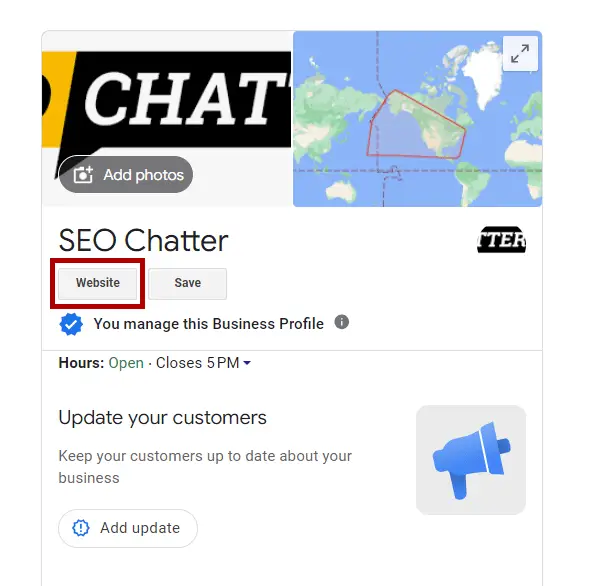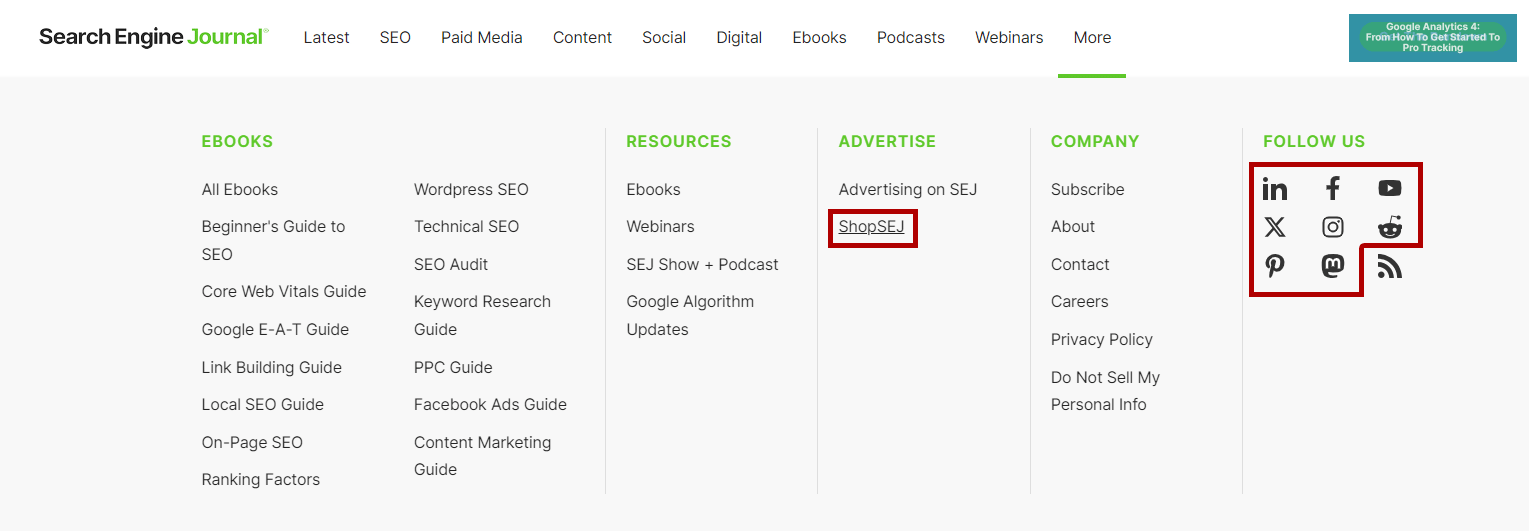A backlink is a link from one website that leads to a page on another site. Backlinks are an important part of off-site search engine optimization (SEO) because backlinks count as “votes” for a specific page by Google’s ranking algorithm systems and other major search engines.
This guide will show you the top examples of backlinks that can be used for link building campaigns in SEO followed by a list of good and bad backlink examples so you know which links to use (and avoid) for your website.
Examples of Backlinks
1. Contextual Backlinks
Contextual backlinks are links placed within the main content on a website that the user reads as opposed to being placed within the header, footer, or sidebar. Contextual backlinks are text links with hyperlinked anchor text that inform search engine crawlers what the target page is about. These backlinks are the most important links for SEO because they pass the most PageRank value from one web page to another.
This link here: what are contextual backlinks, is an example of a contextual link for an internal page on the SEO Chatter site. But this link here: Tax Credits for Homeowners, is a contextual backlink for Energy.gov.
2. Editorial Backlinks
Editorial links are examples of natural backlinks that result from a website owner linking to a web page based on the quality of the content. An editorial link is not paid for, asked for, or traded for, but is received naturally by publishing high-quality content that other site owners think would be beneficial for their readers.
Editorial backlinks can also come in the form of quotes where a journalist reaches out to a particular person to get their opinion on a particular topic. In this case, the website will include a backlink to the expert’s personal homepage or the company they work for.
Below is an example of this type of backlink I acquired for SEO Chatter. You can also learn more about editorial backlinks.

3. Local Listing Backlinks
Local listing backlinks are links that are placed on business directory sites and profile listings such as Google Business Profile, Bing Places, Yelp, TripAdvisor, etc. Local listing backlinks are important for local search engine optimization because they help establish the company as a real entity online.
Below is an example of this backlink on the SEO Chatter Google Business Profile.

4. Author Backlinks
Author backlinks are links that are located in the author bio box on a web page. These backlinks typically include hyperlinks to the author’s website homepage, a specific landing page, and/or social media profiles.
Below is an example of a backlink for SEO Chatter in the author bio box for a guest post I wrote on another website.

5. Header Backlinks
Header backlinks are clickable links that appear on the heading tags within a page’s content. This includes the H2, H3, H4, H5, and H6 headers. The H1 tag is typically reserved for the web page’s title, and having more than one H1 tag on the page is not a good SEO practice. Therefore, an H1 backlink is often not created in the HTML code to link to another website.
A backlink that appears in an H2 subheading is a good place to obtain a quality backlink for SEO because it is the next-highest heading in the HTML structure. H2 heading backlinks can transfer more SEO value to the target page than a standard contextual link because the heading tag is used to define the main topics for the page. A backlink in an H3 tag would be the next strongest factor. H4 to H6 subheaders can be ignored because they are the weakest on-page elements for SEO.
6. Navigation Backlinks
Navigation backlinks are examples of sitewide links that appear in the top section of the website, which is typically where the main navigation menu is located. A navigation backlink looks like it will link to a page that’s on the current site; however, it’s actually an outbound hyperlink that takes the user to another website.
Below is an example of navigation backlinks for the Search Engine Journal site. The links for ShopSEJ and social media accounts lead to third-party sites that are not on the domain.

7. Sidebar Backlinks
Sidebar backlinks are links that are located in the sidebar section (left or right) of a website’s layout. These hyperlinks are considered to be a type of sitewide backlink because they appear on every web page.
Below is an example of sidebar backlinks on Neil Patel’s site. The links are used to point users to the different SEO tools. In this case, the links are internal, but the same concept can be used to link externally to other sites to pass PageRank value for SEO to other domains.

8. Footer Backlinks
Footer backlinks are another type of sitewide link and are considered to be examples of boilerplate links. Footer links are placed in the footer section of the website so they appear on every page. Some people try to use footer links for SEO by adding keyword-optimized anchor text to these backlinks to get as much link equity as possible from the origin site.
However, during a 2012 SMX Advanced Conference in Seattle, Matt Cutts (former head of Google’s Web Spam team) said, “We’ve done a good job of ignoring boilerplate, sitewide links. In the last few months, we’ve been trying to make the point that not only is link buying like that not doing any good, we’re turning the dial up to let people know that certain link spam techniques are a waste of money.” (Source Search Engine Land)
9. Image Backlinks
Image backlinks are links to your website from graphics and photos that include hyperlinks on the image rather than a piece of text. A common example of this link building practice is creating infographics and asking website owners to add a backlink to your website from that image. See this guide on how to get backlinks from infographics for more details about this off-page SEO strategy.
10. JavaScript Backlinks
JavaScript backlinks are links that are embedded in JavaScript code. This programming language is one of the core technologies of the World Wide Web, alongside HTML and CSS, and some technical SEO experts experiment with using backlinks in JavaScript code that Google’s web crawlers can parse.
11. Dofollow Backlinks
Dofollow links are examples of backlinks that directly help with SEO by passing the PageRank authority of the origin website to the destination site. A backlink is naturally a dofollow link unless the site owner adds a nofollow tag to it. When it comes to link building for off-site SEO, you want to obtain as many dofollow links as possible from high-quality sites and web pages to help increase your keyword rankings. (Learn more about what is a dofollow link.)
12. Nofollow Backlinks
Nofollow links are backlink examples that are tagged in a machine-readable way so they do not pass PageRank authority from the origin website to the destination site. These backlinks have the rel=”nofollow” tag added to them in the HTML code. However, this attribute is a hint and not a directive.
In the past, Google did not count nofollow links as “votes” of confidence for the target page. As a result, PageRank value was not transferred to the linked page. But in March 2020, Google changed its link valuing system for crawling and indexing nofollow links on the web. Therefore, PageRank value, another other trust signals may be passed through the nofollow backlink, making these types of links still valuable to get for off-site optimization.
What Are Good Backlinks?
Good backlinks are relevant inbound links from a trusted, authoritative site that are natural and highly relevant to the backlink page. A good backlink also comes from a website with a high Domain Authority and Page Authority score, such as 40 to 80, with optimized anchor text.
Trusted Site
The first example of a good backlink is getting a link from a trusted site is good for SEO because it helps your website seem more trustworthy. Google’s algorithm counts high-quality links as endorsements. The simple fact is that good sites link to other good sites. You can check the trust of a website by using a tool like Moz Pro which includes a MozTrust score that measures the global trust of inbound links to a website.
Authoritative Site
Another example of a backlink that’s good for your website is a link from an authoritative site that demonstrates expertise in its field by providing trustworthy and well-sourced content that’s updated regularly for accuracy. Authoritative websites typically have high Domain Authority scores because other sites on the Internet include backlinks to them because they’re so authoritative in their industry.
High Page Authority
Web pages with a Page Authority score pass the most PageRank value for SEO. Page Authority is derived from other high-quality websites linking to a target URL. Therefore, good backlinks are inbound links to your site from web pages with high Page Authority scores, such as 40 to 80 on a 100-point scale.
Natural Backlinks
The best type of backlinks are natural links that are not paid for, asked for, or have exchanged services for. Natural backlinks come from producing high-quality content that earns good backlinks without the website owner creating them in unnatural ways, which goes against Google’s Search Essentials Guidelines.
Highly Relevant Backlinks
SEO experts and link building professionals agree that the best example of good backlinks is links that come from highly relevant web pages. Getting backlinks from pages that are similar topics helps to boost the topical authority for the target page.
Therefore, you want backlinks on pages that are topically relevant to the target URL on your website. A bad backlink that doesn’t seem natural, for example, would be a link from a page that talks about dog training to a page on another site that’s about car insurance. A good backlink would be from a page about puppy training methods because it’s about a similar topic.
This example of backlinks is an important concept to understand because Google’s algorithm will read the surrounding text of a backlink and use it to help index the target URL for appropriate keywords. The technical term for this is “annotation text”, which has been documented in this Anchor Text Indexing Guide by Bill Slawski. Essentially, you want the surrounding text of the backlink to confirm that the target page is about a specific keyword phrase (or topic) to improve the off-page SEO signals for the link.
Good Optimized Anchor Text
According to Search Engine Roundtable, John Mueller, Senior Webmaster Trends Analyst at Google, said that anchor text does impact rankings. But as Barry Schwartz writes in the article, “anchor text is a signal Google uses for ranking purposes. Yes, Google can ignore spammy links that try to manipulate rankings but normal anchor text does help Google rank a page for what the anchor text says about the page.”
Therefore, if you’re doing link building of any kind then you should adhere to a specific set of anchor text ratio optimization for acquired backlinks. That way, you can reduce the chance of your links looking unnatural or spammy according to Google’s Link Scheme Guidelines. Also, check out this related page with examples of keywords so you know each type of keyword you can optimize for SEO on your website.
What Are Examples of Bad Backlinks?
Examples of bad backlinks include:
- Backlinks from low-quality directories
- Links from spun content
- Link exchanges used to manipulate search rankings
- Excessive 301 redirects; used to reroute all the backlink juice (or link equity) to a specific web page
- Backlinks in blog comment spam
- Links from sitewide footers
- Link wheels or Private Blog Networks links, a network of interconnected websites or web pages used to artificially build backlinks
- Hidden backlinks on a page
- Paid backlinks that are not earned organically
You can learn more about this topic by visiting these other pages on Bad Backlinks, Toxic Backlinks, and Link Spam.
Types of Backlinks
There are many types of backlinks you can create for a website. The backlink examples below show you the most common links you can create with link building campaigns for SEO.
- Guest Post Link Building: These are backlinks that are made through guest blogging opportunities.
- EDU Backlinks: These are links placed on college and university websites.
- GOV Backlinks: These are links that are acquired from local, state, and federal sites.
- Forum Backlinks: These are a type of backlink that come from forum profiles, signatures, and comments on forum posts.
- PBN Backlinks: These are hyperlinks built from a network of connected sites and blogs you own which are commonly known as a Private Blog Network.
- Social Media Backlinks: These are links from social media profiles and posts on sites like Facebook, Twitter, Medium, Reddit, Quora, Pinterest, YouTube, etc.
- Tiered Link Building: This is a backlink strategy that builds links from a variety of sources to your website through a tiered system.
- Web 2.0 Backlinks: These are links from self-publishing platforms that allow user-generated content, like Blogger, WordPress, Wix, Tumblr, Weebly, etc.
- High PR Backlinks: These are the best types of links because they come from other websites that have a high PageRank (i.e., Page Authority).
- HARO Backlinks: These are editorial backlinks that are created through a service called HARO in response to journalist requests.
Before we end this guide, another thing worth mentioning is that there’s often confusion between backlinks vs inbound links; however, they’re basically just different words to describe the same type of hyperlink. Link building experts often use the word backlinks to describe the types of links they acquire for increasing search engine rankings for a website while digital marketers who are not so much focused on SEO use the term inbound links to refer to any hyperlinks that earn referral traffic for a site.
Examples of Backlinks Summary
I hope you enjoyed these examples of backlinks in SEO.
As you discovered, there are many backlink examples that you can use for link building campaigns. However, the best example of a good backlink is one that has high authority, trust, relevance, optimized anchor text, and follows Google’s Search Essentials Guidelines. If you can get those kinds of backlinks during a link building campaign, then you’ll see the best results for your off-site search engine optimization efforts.

